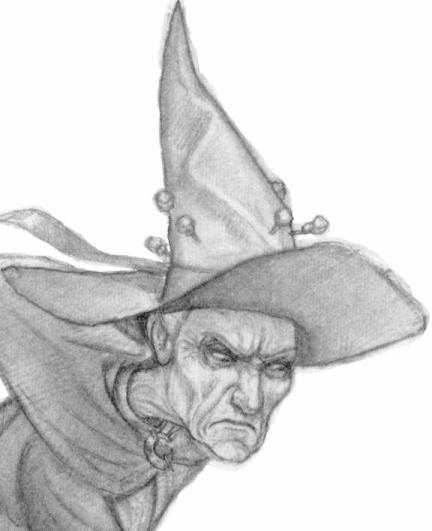 book in the series, Equal
Rites, but since then they have become a force to be reckoned with.
Discworld fans have followed the exploits of three in particular:
Granny Weatherwax, Nanny Ogg and Magrat Garlick.
book in the series, Equal
Rites, but since then they have become a force to be reckoned with.
Discworld fans have followed the exploits of three in particular:
Granny Weatherwax, Nanny Ogg and Magrat Garlick.Witches were not a feature of the Discworld until the
third  book in the series, Equal
Rites, but since then they have become a force to be reckoned with.
Discworld fans have followed the exploits of three in particular:
Granny Weatherwax, Nanny Ogg and Magrat Garlick.
book in the series, Equal
Rites, but since then they have become a force to be reckoned with.
Discworld fans have followed the exploits of three in particular:
Granny Weatherwax, Nanny Ogg and Magrat Garlick.
"Witches are not by nature gregarious, at least with other witches, and they certainly don't have leaders. Granny Weatherwax was the most highly-regarded of the leaders they didn't have." She was also the original witch who made her debut in Equal Rites, although Granny has changed substantially since then. Nanny and Magrat joined Granny in Wyrd Sisters to form a coven of three superbly mismatched individuals who combine to excellent comic effect. In Lords and Ladies, however, Magrat effectively left the coven by marrying a king, and Maskerade was chiefly concerned with securing her replacement, Agnes 'Perdita X. Dream' Nitt. It remains to be seen how well Agnes will function as a foil for Granny and Nanny.
Discworld witches do not fit the stereotype of evil old crones in gingerbread cottages who eat children. Not usually, anyway. They are a central part of the life of their villages, practising midwifery, basic healthcare and enforcing moral codes such as politeness and obedience, with the caveat that such codes do not apply to themselves.
 Granny Weatherwax is definitely
'top witch'. She evidently believes herself to be the finest
exponent of witchcraft on the Disc, and we've yet to see any
evidence that this is not the case. Witch's magic seems to fall
into two broad categories; 'proper' magic and headology. Granny
is accomplished at both, but headology is the more fundamental part of
witchcraft on the Discworld.
Granny Weatherwax is definitely
'top witch'. She evidently believes herself to be the finest
exponent of witchcraft on the Disc, and we've yet to see any
evidence that this is not the case. Witch's magic seems to fall
into two broad categories; 'proper' magic and headology. Granny
is accomplished at both, but headology is the more fundamental part of
witchcraft on the Discworld.
You have to admire Pratchett for coming up with headology. He tapped into the mythology of witches and somehow created this wonderful piece of Discworld lore. Even the word 'headology' sounds like the sort of word a rustic, uneducated old woman might come up with to describe 'the science of the mind'. Headology means, basically, using people's willingness to believe things to get them to believe what you want. For example:
Only once, in the entire history of witchery in the Ramtops, had a thief broken into a witch's cottage. The witch concerned visited the most terrible punishment on him. She did nothing, although sometimes when she saw him she'd smile in a faint, puzzled way. After three weeks... he took his own life; in fact he took it all the way across the continent, where he became a reformed character and never went home again.
Where Granny Weatherwax sometimes seems troubled by her vocation as a 'good' witch, Nanny Ogg has no such problems. She provides a perfect counterpoint to Granny's severity, usually by making lewd remarks. Her plump, good-natured exterior hides a slightly unconvincing insightfulness and 'homely wisdom'. That Nanny successfully strikes a sympathetic cord with the readership is probably best illustrated by the popularity of her 'Hedgehog Song'.
As a group, the Witches have had more books devoted to their exploits than any other characters. You wouldn't immediately pick them out to be stars of a long running series of best-sellers, but that's Pratchett all over: he somehow gets our sympathy working for unwashed, eccentric old baggages who we'd edge away from if they came up to us in the street asking for some change for a cup of tea. Some sort of headology?
Jason Anthony
 Previous page |
 Contents page |
 Next page |
Web pages designed by Derek Moody
May 1998